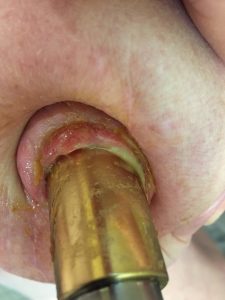Discharge
Incidence and Timing
Another common symptom that was reported by respondents was discharge from the stoma. We used the term “discharge” to find all postings related to stoma discharge. We excluded bloody discharge, as that was covered in the previous section.

The duration of time since the OI surgery was reported by 26 of the 30 respondents, with median time of 67 weeks post surgery (range: 2 weeks – 469 weeks). The postings about discharge from the stoma are more frequent in the first year (0-60 weeks).


Symptoms
The majority of people did not indicate that their discharge was a problem and seemed to expect it. Further, the majority of people who responded to these posts indicated that the discharge they had experienced following surgery steadily abated or “dried up” over the following weeks. It was also noted that the amount of time it took for the discharge to decrease was variable, and many respondents indicated that, at several years post-surgery, they still experienced some discharge. There were also numerous comments suggesting that the food and drink consumed influenced the amount of discharge. In several instances, commenters advised that diets high in sugary or fatty foods, as well as alcohol consumption, increased the amount of the discharge. There were also several reports of increased discharge after trauma to the stoma, such as jamming the abutment or hitting the stoma as a result of a fall. Discharge after an event like that usually returned to normal after a few weeks. There was also reports that an increase or change in daily discharge was due to an infection.
What People Have Tried
The actions that persons took to manage discharge were fairly homogeneous in nature, and usually involved daily cleaning and using breast pads (or some other type of gauze-like pad) to catch the exudate from the stoma. Most respondents indicated that they cleaned their stoma daily when they noticed extra discharge, and some cleaned with Epsom salts and/or a diluted oregano oil solution. One respondent indicated that they cleaned the area with witch hazel and lubricated the stoma with eye drops to minimize any sticking. Another report indicated a reduction in sugar and refined carbohydrates reduced the amount the daily discharge. There was also reports of using baby wipes to clean the stoma and antiseptic wipes to clean the connector during the day if they were not home. One respondent indicated they used peroxide [1] and Bio-Oil to clean and moisturize their stoma. It was reported that antibiotics were taken for an infection which had caused a change in the discharge. Almost every respondent indicated they used a breast pad (or something similar) to catch any discharge that came from the stoma, and some indicated they had to change the breast pad more than once a day if the discharge was heavy. Respondents also indicated the importance of frequently washing clothing and bedding, and allowing the stoma to ‘air out’ without a covering on top of it which would reduce future discharge.
Fact Checker
[1] Hydrogen peroxide should be used with caution as it is an oxidizing agent which may damage cells and slow healing (Daley, 2018).
Help keep this resource alive.
Click this Qualtrics link to complete a survey on discharge so we can continue to grow the information and keep it up to date.
